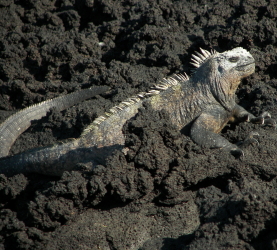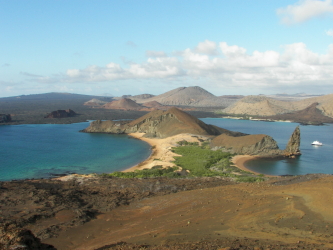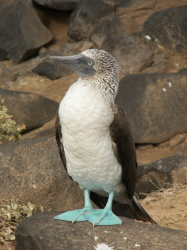|
The Galapagos Islands lie about 600 miles west of Ecuador and straddle
the equator. The islands have never been attached to a mainland,
instead they arose directly from the sea. They are acutally tips
of huge underwater volcanoes. This means that any life on the islands
arrived from other sources of colonisation and is therefore limited
in number of species. Also, being so isolated from other land masses,
nearly half of the plant and animal life on the island are endemic,
that is they occur naturally nowhere else in the world. Charles
Darwin visited the islands in 1835 and from his observations formulated
his theory of the origin of species by means of natural selection.
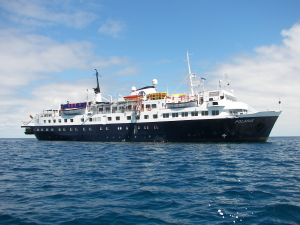 We
visited the Galapagos in November, 2006. We went with Linblad Expeditions
on a journey that combined a trip to the islands with a trip to
Peru and Machu Pichu (click here to see details and photos from
Peru.) In the Galapagos, we stayed on the MS Polaris, an 80 passenger,
246 ft vessel. The staterooms were quite spacious with twin beds,
plenty of closet and drawer storage space and comfortable bathroom
and shower facilitites. Linblad Expeditions has partnered with National
Geographic and offer an outstanding travel experience. We
visited the Galapagos in November, 2006. We went with Linblad Expeditions
on a journey that combined a trip to the islands with a trip to
Peru and Machu Pichu (click here to see details and photos from
Peru.) In the Galapagos, we stayed on the MS Polaris, an 80 passenger,
246 ft vessel. The staterooms were quite spacious with twin beds,
plenty of closet and drawer storage space and comfortable bathroom
and shower facilitites. Linblad Expeditions has partnered with National
Geographic and offer an outstanding travel experience. 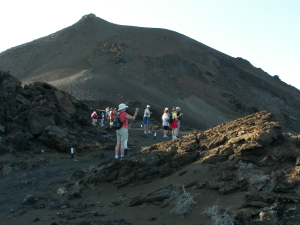 In
addition to daily hikes on the Islands, we were given opportunities
to kayak thru the lagoons, snorkel from the beach and from zodiaks
(all equipment was provided). There was also a glass bottom boat
available for those not wishing to snorkel. In
addition to daily hikes on the Islands, we were given opportunities
to kayak thru the lagoons, snorkel from the beach and from zodiaks
(all equipment was provided). There was also a glass bottom boat
available for those not wishing to snorkel.
Visits to the Galapagos Islands are strictly controlled by the
Galapagos National Park Service (GNPS) in order to preserve the
unique life on the islands. You are only allowed on certain islands
and then only when accompanied by a Park Naturalist. We had 7 naturalists
on board with us who were an amazing source of information about
the unique geology, flora, birds, mammals and history of the islands.
They led groups of no 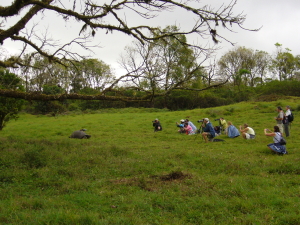 more
than 12 on hikes and zodiak tours of the islands. In addition, the
week we went was a special photo expedition. So in addition to the
naturalists, we were accompanied by 3 professional photographers.
They gave seminars on photographic techniques, made suggestions
in the field and answered questions about using digital cameras.
Special early morning and late afternoon expeditions were offered
to take advantage of the best light for photography. more
than 12 on hikes and zodiak tours of the islands. In addition, the
week we went was a special photo expedition. So in addition to the
naturalists, we were accompanied by 3 professional photographers.
They gave seminars on photographic techniques, made suggestions
in the field and answered questions about using digital cameras.
Special early morning and late afternoon expeditions were offered
to take advantage of the best light for photography.
The Galapagos is one of the most unspoiled places on the planet.
Plant and animal life differs from island to island. And there is
a dazzling diversity of landscapes. But the primary lure of the
islands is that you are able to get very close to the animals. 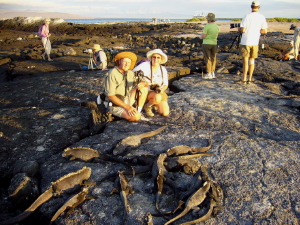 They
have no fear of humans and are totally unconcerned about you being
there. We were able to watch birds performing mating rituals, sea
lions nursing their babies, giant tortoises feeding, all within
a few feet of them. This is very exciting in itself, and a particular
bonus for photographers. We took thousands of photos ( easy to do
with digital cameras!) and have included some of the best ones on
this web site. They
have no fear of humans and are totally unconcerned about you being
there. We were able to watch birds performing mating rituals, sea
lions nursing their babies, giant tortoises feeding, all within
a few feet of them. This is very exciting in itself, and a particular
bonus for photographers. We took thousands of photos ( easy to do
with digital cameras!) and have included some of the best ones on
this web site.
Under the tab Galapagos Journals, you can find a description of
each day of our trip, the islands visited, animals encountered,
hikes and other activities we participated in, as well as photos
taken that day. To look at a full screen view of any picture, just
click on the photo. Under the Photos tab, you can select a galary
of photos on a specific subject (e.g. Giant Tortoises). There is
a map of the Galapagos Islands under the Map tab with our route
highlighted.
We hope you enjoy reading about our trip and viewing the amazing
birds and animals we had the privilege of photographing.
Home Journals
Photos Map
Contact Us
|
